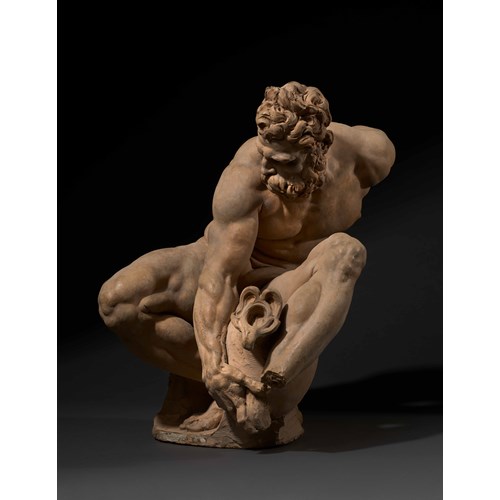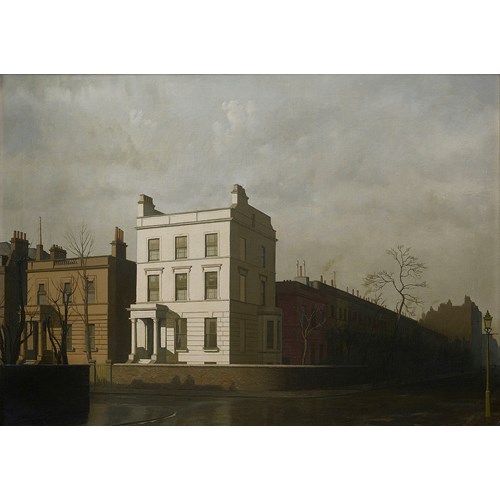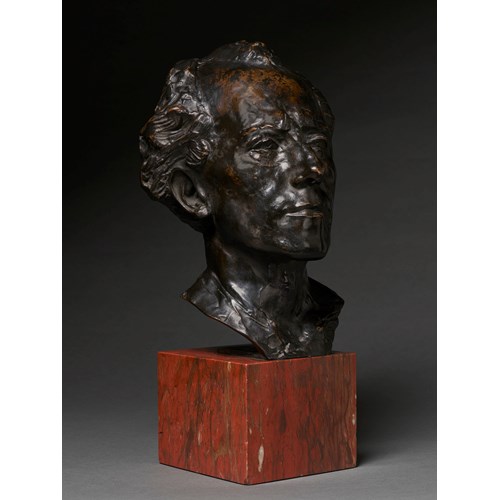Marketplace
East Valley, Cuenca
David BOMBERG
East Valley, Cuenca
Date 1934
Dimension 52.4 x 67.3 cm (20⁵/₈ x 26¹/₂ inches)
The fascination that Bomberg clearly felt for the Spanish hillside towns that he came across during his travels in the 1930s is demonstrated in the present work. He had had a disappointing trip to Russia in 1933 and decided to head to Spain, which had previously been a huge inspiration to him. During his previous Spanish trip Bomberg had spent a productive winter at Toledo, painting over twenty canvases of the city and surrounding landscape. It was during this trip that a small engraving of Cuenca caught Bomberg's eye while he was staying at a pension in Madrid with Lilian that inspired him to visit and paint the dramatic location of this Spanish town.
The city of Cuenca is known as 'Eagles Nest' because of its position, perched high up on a hill and separated from the nearby rock face by deep ravines in which the rivers Júcar and Huécar run. The dramatic location of Cuenca inspired Bomberg to produce works in which the surrounding landscape gained a greater emphasis and the buildings become almost absorbed within it. As with the paintings that he produced in Toledo and Palestine (see lots 56, 57 and 60), Bomberg painted outdoors, as often as possible, exploring the surrounding countryside on a donkey to find suitable vantage points from which to study and paint Cuenca.
Richard Cork comments, 'If Toledo had provided him with the breakthrough he needed, other Spanish sites might help him reach an even deeper understanding of the natural forces he cherished. In 1934, armed with the proceeds of sales to three Bradford collectors who showed a rare appreciation of his work, he set off with Lilian for Cuenca. Perched high on a rock ridge with rivers on either side, the ancient town provided Bomberg with an ideal interplay with buildings and the landscape they so dramatically occupied. His paintings stress the rootedness of Cuenca's houses, the way they appear to grow out of the rock on which they stand. In the most elaborate picture he carried out there, Cuenca from Mount Socorro [sold Christie’s for a then record price, £1,016,000, 17 November 2006, lot 101], town and rock are fused in an energetic mass filled with Bomberg's heightened awareness of a geological conflict between cohesion and stress. As at Toledo, sunset fired him to see the town in near-visionary terms, when the houses appear to lose much of their substance and dissolve into a landscape suffused with the incandescence of dying light. Unlike Toledo, however, Bomberg's brushwork now strives for a greater breadth, shedding the intricacy of the 1929 work in favour of a more summary and unified approach to form (see Exhibition catalogue, David Bomberg, London, Tate Gallery, 1988, pp. 30-31).
Dr Henry Roland, who along with Gustave Delbanco and Lillian Browse, founded the gallery Roland, Browse and Delbanco, wrote in relation to the present work, 'I share the painter's enthusiasm for rugged Spanish hillside towns and am impressed by the consistence of his brushwork. Non-descriptive short parallel strokes of thick impasto paint add up to a convincing view' (loc. cit.).
The city of Cuenca is known as 'Eagles Nest' because of its position, perched high up on a hill and separated from the nearby rock face by deep ravines in which the rivers Júcar and Huécar run. The dramatic location of Cuenca inspired Bomberg to produce works in which the surrounding landscape gained a greater emphasis and the buildings become almost absorbed within it. As with the paintings that he produced in Toledo and Palestine (see lots 56, 57 and 60), Bomberg painted outdoors, as often as possible, exploring the surrounding countryside on a donkey to find suitable vantage points from which to study and paint Cuenca.
Richard Cork comments, 'If Toledo had provided him with the breakthrough he needed, other Spanish sites might help him reach an even deeper understanding of the natural forces he cherished. In 1934, armed with the proceeds of sales to three Bradford collectors who showed a rare appreciation of his work, he set off with Lilian for Cuenca. Perched high on a rock ridge with rivers on either side, the ancient town provided Bomberg with an ideal interplay with buildings and the landscape they so dramatically occupied. His paintings stress the rootedness of Cuenca's houses, the way they appear to grow out of the rock on which they stand. In the most elaborate picture he carried out there, Cuenca from Mount Socorro [sold Christie’s for a then record price, £1,016,000, 17 November 2006, lot 101], town and rock are fused in an energetic mass filled with Bomberg's heightened awareness of a geological conflict between cohesion and stress. As at Toledo, sunset fired him to see the town in near-visionary terms, when the houses appear to lose much of their substance and dissolve into a landscape suffused with the incandescence of dying light. Unlike Toledo, however, Bomberg's brushwork now strives for a greater breadth, shedding the intricacy of the 1929 work in favour of a more summary and unified approach to form (see Exhibition catalogue, David Bomberg, London, Tate Gallery, 1988, pp. 30-31).
Dr Henry Roland, who along with Gustave Delbanco and Lillian Browse, founded the gallery Roland, Browse and Delbanco, wrote in relation to the present work, 'I share the painter's enthusiasm for rugged Spanish hillside towns and am impressed by the consistence of his brushwork. Non-descriptive short parallel strokes of thick impasto paint add up to a convincing view' (loc. cit.).
Date: 1934
Signature: Signed and dated: Cuenca 1934 David Bomberg
Dimension: 52.4 x 67.3 cm (20⁵/₈ x 26¹/₂ inches)
Provenance: Fine Art Society, London
Private collection, acquired in 1948, and by descent to 2007
Christie’s, London, 16 Nov 2007, Lot 48
Steve Martin Collection, Los Angeles, to 2018
Plus d'œuvres d'art de la Galerie









